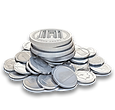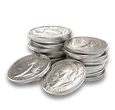Exit Strategies for Precious Metal Investors
- GoldsilverJapan

- Sep 25
- 6 min read
When and How to Sell for Retirement, Emergencies, or Profit-Taking
In the world of precious metals investing, the exit strategy is just as important as the entry point. Many investors spend years accumulating gold and silver but freeze when it comes time to sell. Whether you’re planning for retirement, facing an unexpected emergency, or simply locking in profits, understanding when and how to sell your metals is crucial.
This guide explores strategic and well-timed approaches to exiting your gold and silver positions—providing practical advice for retirement planning, portfolio rebalancing, market timing, and asset conversion.
🔑 Why Exit Strategy Matters
Investing in gold and silver is often about wealth preservation. However, at some point, you’ll need to use that wealth—either to cover retirement expenses, seize new investment opportunities, or navigate financial emergencies.
A well-planned exit strategy allows you to:
Maximize returns by timing sales smartly
Avoid emotional decision-making
Reduce tax liabilities with careful planning
Convert metals into income-producing assets
Ensure liquidity during emergencies
Whether you’re selling a few coins or an entire portfolio, having a clear exit plan prevents panic selling or missed opportunities.
🕰️ When Should You Sell Your Precious Metals?
The timing of your exit depends on your financial goals. Here are some common scenarios:
1. For Retirement
Many long-term investors accumulate gold and silver over decades. When retirement approaches, it may be time to start liquidating metals gradually to supplement income.
Sell your holdings:
When you start drawing retirement income
When the metals market hits favorable levels
When converting to cash or income-producing assets
2. For Emergencies
Gold and silver are often referred to as “crisis hedges.” If you face a job loss, medical emergency, or unexpected expense, your metals are a source of liquidity.
In these cases:
Sell enough to cover the immediate need
Prioritize selling low-premium bullion first
Consider local dealers for quick access to funds
3. For Profit-Taking
Many investors choose to sell in portions when prices rise significantly.
Rather than trying to "sell at the top" (which is nearly impossible to predict), consider this strategy:
Sell your holdings in 4 to 5 portions at different price levels
Use predetermined milestones or percentage gains
Take advantage of price spikes while keeping exposure
📊 Portion-Based Selling Strategy (Staggered Selling)
One of the most effective strategies for exiting is staggered selling—selling parts of your holdings in multiple stages rather than all at once.
Why This Works:
Reduces regret from poor timing
Captures gains as prices rise
Keeps part of your hedge intact
Example:
Sell 20% of your holdings when prices hit a new multi-year high
Sell another 20% during another rally
Retain a final portion as a long-term hedge or legacy asset
This method also reduces tax shocks and allows you to reallocate gradually into other asset classes.
🔁 Reinvesting into Other Assets
Selling your gold or silver isn't always about converting to fiat currency. Often, it’s a strategic reallocation into another investment that aligns with your goals.
Use Proceeds To:
Buy income-producing real estate
Invest in dividend-paying or high-value stocks
Open a small business or invest in entrepreneurship
Pay off debt or lower long-term liabilities
💡 Asset Conversion Example:
Sell 30 ounces of gold to fund a down payment on a rental property
Use rental income for retirement income while gold stabilizes
💱 Gold vs Asset Ratios: Beyond Fiat Valuation
When planning to sell your metals, don’t rely solely on fiat currency prices like USD or JPY. These currencies are subject to inflation and monetary manipulation.
Instead, consider evaluating gold’s value relative to other assets to determine if it’s a favorable time to sell.
🟡 1. Gold-to-Real Estate Ratio
Ask: How many ounces of gold does it take to buy a 100-square-meter apartment in your area?
Historically:
When gold is undervalued, it takes more ounces to buy real estate.
When gold is strong, fewer ounces are needed.
If your gold can now buy significantly more real estate than before, that may signal a strategic time to convert some metals into property.
📈 2. Gold-to-Dow Ratio
Ask: How many ounces of gold are needed to purchase the Dow Jones Industrial Average (or equivalent index)?
In 1999, it took 45 ounces to buy the Dow
In 2011, it dropped to 6 ounces
Today, tracking this ratio helps identify relative overvaluation in stocks vs metals
Using these ratios helps you:
Avoid chasing dollar prices
Sell when gold is strong relative to other hard assets
Make smarter portfolio shifts
💵 Dealer Spreads and Fees: Know the Cost to Sell
One of the most overlooked factors in selling is the dealer spread—the difference between the spot price and what a dealer pays you.
For example:
Spot price of gold: $3,700 per ounce
Dealer offers: $3,600 per ounce
Spread: $100 loss per ounce
Important Notes:
Spreads vary by dealer and by product type
Coins with high liquidity (like Maple Leafs, Eagles, or Krugerrands) usually get better offers
Bars and lesser-known products may be discounted more
In tight markets with high demand, spreads may shrink
In crises or low-demand markets, spreads may widen
👉 Always check multiple buyback prices before selling.
Additional Fees:
Some dealers also charge:
Testing or assay fees (especially for large bars)
Shipping or insurance fees (for mailed-in sales)
Handling fees (for bulk liquidation)
Be sure to ask for a net offer before committing to a sale.
🧾 Taxes: Prepare Ahead of Time
While tax laws vary by country and region, selling gold or silver for a profit may incur capital gains taxes or sales reporting requirements.
Key points:
Understand your local tax laws before selling
Keep all purchase receipts and sale documents
Work with a tax advisor to minimize surprises
You may be eligible for exemptions or reduced tax rates depending on your holding period or transaction size.
Note: This is general guidance. Always consult a local tax expert for country-specific rules.
🏢 Where to Sell Gold and Silver
Choosing the right buyer can maximize your return and reduce risks.
✅ Options Include:
Reputable Bullion Dealers
Like GoldSilverJapan, APMEX, Tanaka Kikinzoku
Licensed (e.g., 古物商 license in Japan)
Transparent pricing and secure handling
Local Coin Shops
Offer convenience and immediate payment
Good for smaller sales
Prices may vary—compare quotes
Online Marketplaces
Platforms like Mercari, Yahoo Auctions (in Japan)
Higher return possible via direct buyer sales
Requires handling, shipping, and trust with buyer
Precious Metals Exchanges
Some countries have gold exchanges or certified auction houses
Pawn Shops
Last resort. Usually offer lower rates
🔐 Security Tips When Selling
Meet in safe, public locations or secured dealer offices
Avoid advertising large sales online or on social media
Use insured shipping if mailing products
Count and document every coin/bar
📘 Case Study: Strategic Exit in Action
Investor A accumulated:
100 oz of silver
25 oz of gold
Held for 10 years
Gold price rises sharply due to inflation fears. Rather than sell all at once, they:
Sell 5 oz of gold at first price rally
Wait for another 10% increase, sell 5 more
Use proceeds to invest in a rental property
Retain 15 oz for future insurance
Result: They benefited from rising prices, captured income from real estate, and still held a crisis hedge.
🔄 Timing vs Value-Based Selling: The Smart Exit
Rather than chasing the “highest price,” think long-term:
✅ Sell when:
Gold is high relative to real estate or stocks
You need to convert to productive assets
You reach a life milestone (retirement, inheritance, etc.)
❌ Avoid selling:
In panic during corrections
Based only on short-term price drops
Without comparing relative value of other assets
📌 Summary: Key Takeaways
Factor | Gold & Silver Exit Strategy |
Best Exit Timing | Retirement, emergency, or asset reallocation |
Selling Method | Portion-based (4–5 sales over time) |
Conversion Strategy | Into real estate, dividend stocks, or business capital |
Value Comparison Tools | Gold-to-Real Estate Ratio, Gold-to-Dow Ratio |
Key Costs to Monitor | Dealer spread, fees, taxes |
Ideal Selling Platforms | Licensed dealers, online platforms, local coin shops |
Security & Documentation | Essential for safe, traceable transactions |
📍 Final Thoughts
Whether you’re a seasoned stacker or a new investor, your exit plan matters as much as your entry.
Selling gold and silver is more than turning metals into cash—it’s about repositioning your wealth for the next phase of life.
By planning ahead, selling strategically in portions, and watching value-based asset ratios, you’ll avoid costly mistakes and extract maximum value from your metals.
If you're ready to start your exit strategy, or just want to explore your options, our team at
GoldSilverJapan is here to help. From buyback programs to storage and market insights, we make the journey from holding to selling seamless and rewarding.











Comments